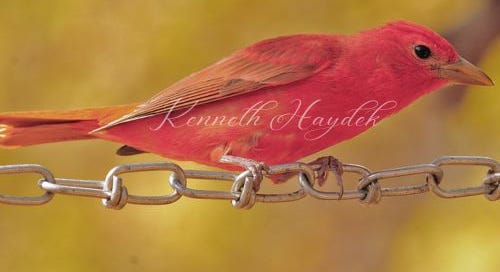July: The Summer Tanager
If summertime brings to mind thoughts of rich strawberries, glistening cherries, juicy watermelon, and roses in full bloom, here’s one more delightful—and thoroughly red—item for your list: the summer tanager.
While northern cardinals have black feathers on their faces, and scarlet tanagers have black wings, the summer tanager is the only entirely red bird in North America. Adult males are stunning rose-red all over, all year round, while females and immature males are yellow-green. Immature males, in fact, begin with subdued yellow-gray-brown feathers, which are quickly replaced by the same yellow-green feathers of females. When juvenile males make their first spring migration, they undergo a partial molt, giving them an erratic patch-work of yellow, red, and green feathers. (And who said the gawky teenage phase was just for humans?) It isn’t until their second molt that male summer tanagers come completely into their own, wearing a dashing red suit that stays with them the rest of their lives.
One might think that such bright birds belong in the tropics, and that it true, at least part of the year. Summer tanagers are long-distance migratory birds and spend their winters from Mexico to Central America all the way to the middle of South America. For breeding grounds, though, summer tanagers head primarily to the southern and mid-Atlantic United States.
Their habitats vary on where they land on the map. Summer tanagers who stake out breeding grounds in the east seek out the edges of open hickory and oak woodlands or mixed oak-pine forests for their habitats. In the west, summer tanagers will often find their homes in low-lying areas near rivers populated with willows and cottonwoods, or at higher elevations, in stands of mesquite trees.
As they live among the leaves, summer tanagers can be disappointingly hard-to-spot, despite their bright color. Birders then, listen for their pity-tuck-tuck song, which has been described as sounding much like the song of a robin, one who may be feeling just a little lazy and slow in the summer heat. Take a listen.
Summer tanagers are small-ish stocky birds with big heads and thick, blunt bills. These bills are perfect for snatching from the air their favorite food—bees and wasps. Stingers do not intimidate these plucky songbirds. When they catch a bee or wasp, summer tanagers smack their prey against the side of a tree. Once their meal is subdued, they use the tree to scrape off the stinger before ingesting. Summer tanagers will use this tactic to first devour adult bees and wasps and then go after their larvae. Beekeepers consider summer tanagers a nuisance to their hives but, because of the limited number of bees they consume, not a real threat to the survival of their hives. These birds will also eat a variety of other large insects, including cicadas, grasshoppers, flies, and moths.
Both male and female summer tanagers will feed their young, even for a few weeks after they have left the nest. Summer tanager nests are often parasitized by cowbirds, whom the males try vigorously to defend against.
As summer turns into fall, summer tanagers fatten up for their long flight ahead to their wintering grounds. In the winter, summer tanagers incorporate more berries and small fruit into their diet, which they pick by hovering near a plant or by plucking it from a perched position. Summer tanagers are rather solitary birds who migrate by night and don’t often migrate in flocks. If they make a stopover in your backyard, it won’t be to visit your feeder since seeds are not really part of their diet. They may go after suet blocks, though, especially in cooler weather, or clean off in a birdbath. They’ve also been known to be enticed by small dishes of grape jam or jelly left out by welcoming neighbors.
So as you soak up all the pleasant sights of summer, keep your eyes open for our feathered friend in red, who undoubtedly would be happy to make your list of summertime favorites.
Sources:
https://www.allaboutbirds.org/guide/Summer_Tanager/overview
https://www.audubon.org/field-guide/bird/summer-tanager
https://ebird.org/species/sumtan
https://abcbirds.org/bird/summer-tanager/
https://backyardbirdcenter.com/summer-tanager
https://www.birdsandblooms.com/birding/bird-species/tanagers-and-blackbirds/summer-tanager/



